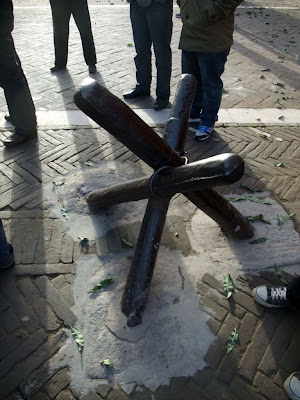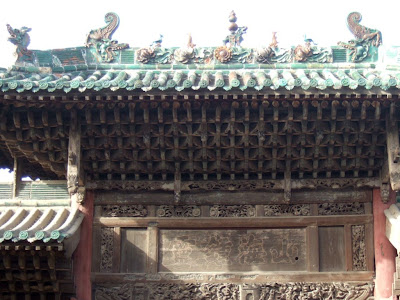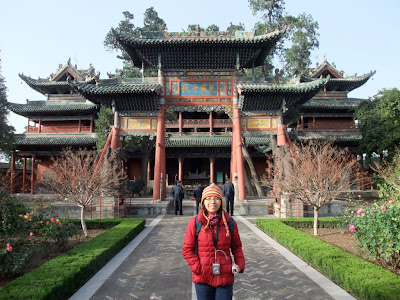
The Quandi Miao at Haizhou of Yuncheng (解州关帝庙) is China's biggest and best preserved temple complex to memorialize the courage and royalty of Guan Yu (关羽), a legendary general from Three Kingdom period (220-280). General Guan Yu (160-219) was borne in the little village of Changping in Yuncheng but was forced to ran away from his hometown to other state as he had killed a ruffian in the village. He later met Liu-bei and Zhang-fei and pledge in a sworn brotherhood with two of them. He swore to assist Liu-bei to regain the Han Dynasty and was faithfully with him for 35 years.



The Temple site originally covered a land of 66,000 sq. meter and was first constructed in year 589 during Sui Dynasty (581-618)and restored, expanded, rebuilt several times in Song, Ming and Qing Dynasty (1644-1911). The scheme of today's temple complex took 10 years to rebuilt during the reign of Emperor Kangxi in Qing Dynasty after it was burnt down by fire in year 1072.



There are 4 main parts from north to south along the central axis. The park in memory of the three swore brotherhood is at the southern end. The park is made up of 3 main structures which covers a portal, a kiosk a pavilion (结义坊,君子亭和三义阁) with a lotus man-made pond and landscape.



The portal of Swore Brotherhood Park (结义园)


The lazuli dragons wall is situated at the front yard of the building complex, facing north towards main gate direction.


The old lazuli dragon wall had to be supported from the back preventing it from collapse.


The Tripod like iron rod structure between the dragon wall and main gate was meant for the military generals to get down from horses and ministry officials from sedan chair carriages.



This was the place where all passengers had to get down when visiting the Temple.



Main Gate which was known as Duanmen has three doors and the central door could only be used by Emperors or royal family.



The Duanmen (端门)



The two iron lions protector at the main gate were believed to be transformed from Guan Yu's faithful horse Red Hare (千里赤兔马)。




How people respect and honor The General Guan Yu can be read from all these praise verses engraved, carved or inscribed on the portal, archway plaque or tablets.



The main Temple complex at the northern part of central axis, were built in accordance to the tradition palace architectural style. The site occupied a total land area of about 18570 sq. meter covered with structure of Duan-men, Wu-men, Yushulou, Zhong-lin-Dian in the central front yard and Bell and Drum Towers by the side. There are more than 100 halls within the site.



Zhimen (雉门)is the central door that the emperors used to enter the temple. Hanged on top of the central door was the three golden words of Chinese character for Guandi Miao (关帝庙).




The ancestral hall was also located in the front yard.




The central door was only meant for Emperors. So to enter the temple site, all Ministry officials had to use the east door named Wenjin-men (文经门) while military generals would have to use west door called Wuwei-men (武纬门).




The stairway behind the central door when covered with wood plank would become a performance stage of opera shows.


Impressive and attractive roofing of the stage house building.



Opera show stage.


Stage House's old wooden pillar in a metal holder.



The two old doors written with "Old legends, witness now 古演今证" and the two representative animal engravings on the left and right side of the wall.




Wu-men is a broad structure in the front line of central axis. The building is surrounded in a stone barrier and with interesting stone carvings corridor.


There are 144 illustrations of various engraved designs in animals and people at the railing board.




Some of the engraved designs and stone carving sculpture, vivid and lifelike.




Chronicle of Guan Yu was illustrated at the left and right halls of northern end of Wu-Men while the images of Guan Yu's subordinates, the two Generals from three kingdom, Zhou-cang and Liao-hua (三国名将周仓和廖化) were on the corner wall at the other end.




The archway of Shang-Hai-zhonglin (山海钟灵) erected after Wu-men before the Yushulou (御书楼).


Shang-Hai-zhonglin Portal (山海钟灵牌坊)


The original name of Yushulou (御书楼) was Bagua Tower (八卦楼) but when was it been built, it's unknown. The name was changed to Yushulou which literally means tower with royal writings by Emperor Qianlong of Qing Dynasty in year 1762 in memory of his grandfather, Emperor Kangsi who wrote "Virtue and rightness on heaven and earth 义炳乾坤 " on the board.




Tower of Yushulou (御书楼)



The main hall, Zhonglin-dian situated at the heart of temple complex. General Guan yu was designated as the "True king of Zhonglin" by Emperor Song Wei Zhong in year 1102. The main shrine building was built with 52 stone pillars, 50 railing boards and has 200 carving relief. In the front square, there are two ornamental stone pillars, a flag pole and two metal burning stupa.



The two ancient burning stupa 焚表塔 stand on the left and right side of the main hall square.




The attractive 26 dragon pillars at the corridors of the main hall appeared in different posture and expression. In ancient China, only the palace was permitted to have dragon pillars in building. General Quan-Yu had been designated and raised to a rank of nobility by various emperors in Song, Ming and Qing Dynasty and was granted to as high as a king's status.




Many of the tablets were inscribed with the hand writings of various emperors especially from Qing Dynasty, which reflects the important position of Quan Yu in the eyes of China's Emperors. These two inscribed board at the main shrine, were the hand-writings of Emperor Qianlong and Xianfeng.


The Bell and Drum Tower and stele pavilions.




Basing on his faithful royalty, General Guan-Yu was highly respected and honored continuously, after the death for even hundreds and thousands of years later, as from the praising verses inscribed on tablets or plaque.



The three green dragon knives (青龙偃刀) displayed at the corridor side carried a weight of 150 kilograms



The main shrine hall of Zhonglin-Dian enshrined a seated image of General Guan-yu in the dress of an emperor.



The copper incense altar with two iron storks right in front of main shrine are some of the artifact from the Temple site.



The Huge grinding slab which was said to be meant for General's Green Dragon knife.




Many of ancient old trees at the site are above 1000 years old in age. The pine tree has gone through a history 1400 years.




Ancient old building amidst in a garden of bright blooming roses creating a scenic sight for all its visitors while going through the way to his reading chamber, Chun-Qiu-Lou.



The majestic hall of "Chun-Qiu Lou" (春秋楼) housed a lifelike seated image of Guan Gong reading the popular Confucian classics Chun-Qiu at night in a room with all verses of the book engraved on the wall.



Erected in front of the Chun-Qiu Lou is the largest wooden Portal or archway. On its east was the Seal Tower which hold a model of the royal jade seal that appointing the General to a rank of marquis. On its west was the Knife Tower which display the model of the Guan-Yu's Green Dragon Knife.



The top ceiling of the hall was built directly to face the seven North Dipper Stars of galaxy.



The beauty of the construction of Chun-Qiu-Lou building is that its corridor pillars were built to stepping on the lower layer of lotus pillars, making them appear as if hanging in the air.



The iron men and iron lions are some of many artifacts remain at the site in Quandi Miao while the newly added royal garden was built at the back yard of temple site.



The ancestral hall of Guan Yu's father-in-law, located at one corner in the complex, was built by Hu's descendents during Tang dynasty.



General Guan Yu is the hero of Yuncheng locals. His statue was erected at almost every corners and there is always a sculpture of a red horse in one of the hall. His riding horse "Red Hare" starved to death when he was killed.



The huge golden statue of General Guan Yu riding his horse "Red Hare" stands at the front center of Yuncheng Bus Station.



The snack "Ma-hua" is a very popular local delicacy in Yuncheng. It is made from wheat flour, very plain in taste but very cheap in price at only one RMB each.



Yuncheng, the southernmost municipality in Shanxi Province that borders Henan to the south and Shaanxi to the west, like other cities in Shanxi, besides famous for its ma-hua, also very popular in noodles. We enjoyed its pumpkin bun as well as this bowl of mix vegetable soup noodle recommended by a local tourist from Chongqing of Hunan.



Yuncheng is also well known for its Chinese burger by using chopped minced pork or taufoo, handmade in the stall when you order. As it is not too far from Shaanxi, there are plenty of Muslim food restaurants and stalls in this corner.


No comments:
Post a Comment